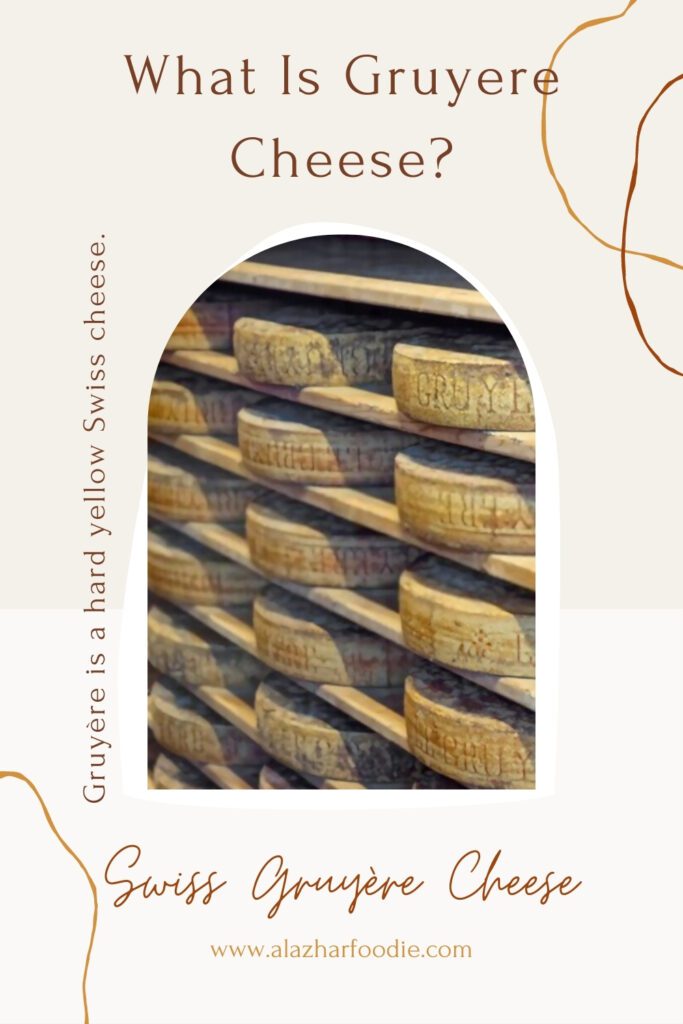What Is Gruyere Cheese?

Hello partners! Today we bring you another delicious cheese. Like the other cheese recipes, today’s one is detailed, and we tell absolutely everything about this characteristic cheese. How good a gourmet product it is, it has followers almost all over the world, and it is sold even in China. Don’t you believe it, then stay with us, we will tell you all about the delicious Gruyere, Gruyère or Gruyere cheese.
Gruyère is a Swiss cheese that gets its name from Gruyère, a district in the canton of Friborg where it is made. The authentic originating cheese is called Le Gruyère AOC to distinguish itself from the rest of the productions, although the Dictionary of the Royal Spanish Academy accepts Gruyère as an appropriate generic name, defining as such a soft cheese, of Swiss origin, made with cow’s milk. and crushed rennet.
Origin of Gruyere cheese
The first references to the Gruyere date back to the year one thousand one hundred and fifteen. But the place name associated with cheese does not appear until the beginning of the s. XVII, on the occasion of the visit of the representatives of the French embassy, who were entertained with cheeses from Le Gruyère.
What is Gruyere Cheese – Feature Wise?
Features Gruyere Cheese
- Gruyere cheese is a hard cheese made from whole cow’s milk, semi-hard, pressed and cooked. Its wheel is round in shape and has a grainy, uniformly brownish and healthy crust. The format must be normal and well proportioned.
- The bead of the wheel must be slightly convex. Its dimensions must be height, from nine to five to twelve cm (from eight to thirteen in the legislation of Spain); diameter, from fifty-five to sixty-five cm, for a weight of twenty-five to forty kg. It can also have a prismatic shape.
- Its bark is dry, washed and brushed, but slightly damp, it has a hard consistency, a greasy appearance and a golden yellow to brown colour and pitted with small holes.
- The pasta is thick, hard and compact but flexible so it can be cut easily and presents ivory to light yellow colour depending on the season.
- It is a cheese in which round eyes can appear in variable numbers distributed regularly and a diameter of the half to one centimetre, although as a general rule it does not have holes since it is either essential.
- The flavour is fragile, robust and with a pronounced aroma. With an approximately brackish note, the fruity tastes that dominate can change according to the preparation zone. The flavour is very fruity, with an acidity that stimulates the palate.
- When the crust is pressed you can feel a taste related to wine. When a Gruyere Cheese is cut, the aroma that it gives off resembles that of a million meadow flowers trapped in the buttery milk. Somewhat grainy, Gruyere cheese has a fantastic difficulty in taste, at first fruity, then but earthy and with a nutty taste, its taste survives on the palate.
Nutritional information Gruyere Cheese
This is the nutritional information for 100 grams of Gruyère cheese :
- Each 100 g of Gruyère cheese contains 36 g of water, 29.81 g of protein, 900 mg calcium, 600 mg phosphorus and 1.4 g salt. The energy value of this cheese is 413 calories with 32 g of fat and 0.36 grams of carbohydrates, which provides excellent benefits for the body.
- The calcium present in Gruyere cheese stimulates the strengthening of the bone system including the teeth. It is extremely effective for people with osteoporosis.
- Given the high presence of protein, this cheese is especially recommended for athletes or adults who want to build and preserve their muscles.
- The phosphorous content in Gruyère cheese also provides strengthening of bones and physical resistance, as well as the balance in healthy skin, thanks to the fact that it helps to preserve the natural pH.
- Its high salt content is not recommended for people who follow a diet for overweight, for hypertensive people or for those who suffer from cholesterol.
Appellation of origin
T his cheese originates from the Gruyère area, in the highlands of the canton of Friborg, where the cheese tradition has been passed down since the s. XII. In this canton 2 languages are chatted, French and German, but the latter only in a small area. Its production area extends over the territories of the Swiss cantons of Friborg, Neuchatel, Vaud, Jura and Bern. The production area of Le Gruyère AOC cheese is the plateau that extends to the Freiburg Alps.
Gruyère cheese Making
The steps to make Gruyere cheese are as follows:
- It has exactly the same way of preparation as the Emmental but on the contrary to it, throughout the maturation, it is kept wet with brackish water to speed up the process.
- It is a cheese made with whole cow’s milk that is solidified through rennet or other authorized solidifying enzymes. After cutting the curd into grains the size of wheat grains, it is heated to a minimum temperature of fifty degrees after which the mass is removed from the whey. The dough is put into moulds by pressing it hard.
- Later, the cheese is fermented at a minimum temperature of 20C for at least 3 weeks, during which lactic fermentation and fermentation are generated throughout the cheese.
- The cheeses are salted by placing them in brine and/or by salting their surface dry; throughout maturation, except in the case of blocks without the rind, the surface of the cheeses is washed, cleaned and salted at regular intervals.
- It takes about 400 litres of milk to make a 35 kg wheel. As the cheese matures, the rind is moistened with pure brackish water, to speed up the ripening time and give it its own fragrance. Le Gruyère AOC cheese is kept for between five and twelve months.
What is Gruyere cheese like?
Gruyère is a cow’s milk cheese with a clean brownish uniform colour, like an ivory yellow; in general, it has a mild, sweet, nutty flavour. However, the taste and texture tend to vary as the cheese ages. When it is younger, it is usually creamier and the nutty flavour is more accentuated, it may have a fruity touch as a result of lactic fermentation. As it ages, it develops a harder texture and a more intense flavour, because it is a salty cheese, because it is aged in a salty water solution. Like most Swiss cheeses, the Gruyere is full of many little holes.
Its shape is a wheel with a grainy crust and its base is slightly curved. It has a height of 9.5 to 12cm, a diameter between 55 and 65cm and weighs between 25 and 40kg. The presence of holes can be noticed, however, it is not essential.
What is Gruyere cheese similar to?
As it is Swiss cheese, it is very common to substitute or confuse Gruyere cheese with Emmental. Both are manufactured under similar conditions and retain excellent quality, however, the Gruyère is positioned with much superiority. The Emmental cheese has an appearance with many holes large in size, while the Gruyère, these gaps are scarce or nonexistent. The colour of the Emmental also has a more intense yellow colour than the Gruyère.
Another cheese that can be used well in place of Gruyere is Swiss Jarlsberg, a Norwegian cheese that retains a similar flavour to Gruyère. The combination of fontina cheese and Parmesan also allows a result very similar to Gruyère cheese with a delicate nutty flavour.
What is Gruyere cheese used for?
Gruyere cheese is generally known as one of the best baking cheeses, with a distinctive but not overpowering taste. In a quiche, Gruyere adds flavour without overshadowing the other ingredients. It is a good cheese to melt, especially suitable for fondues, together with Vacherin Fribourgeois and Emmental.
It is also traditionally used in French onion soup, as well as croque-monsieur, a classic French toasted ham and cheese sandwich. Gruyere is also used in chicken and beef cordon bleu. It is a good table cheese, and when grated, it is often used with salads and pasta. It is used, grated, on top of touring, a type of garlic soup from France that is served on dry bread.
What is Gruyere cheese taste like?
When young, it is creamy with a sweet flavour and strong fruity and nutty notes; when ripe, it becomes tougher and has a stronger, salty flavour. Its flavour lingers on the palate.
What is Gruyere cheese good for?
White wines are best suited for pairing the cheese Gruyère, one overcoat sweet and light, try a Riesling or Chenin Blanc. A dry sparkling wine, like a Prosecco, is also a good option.
What is Gruyere cheese made from?
- Made from cow’s milk
- Country of origin: Switzerland
- Type: hard
- Fat content: 40-46%
- Texture: compact
- Vegetarian: no
NUTRITIONAL INFORMATION
- Quantity per 100 grams
- Calories 413
- Total fat 32 g
- Saturated fatty acids 19 g
- Polyunsaturated fatty acids 1.7 g
- Monounsaturated fatty acids 10 g
- Cholesterol 110 mg
- Sodium 336 mg
- Potassium 81 mg
- Carbohydrates 0.4 g
- Dietary fibre 0 g
- Sugars 0.4 g
- Protein 30 g
- Vitamin A 948 IU Vitamin C 0 mg
- Calcium 1,011 mg Iron 0.2 mg
- Vitamin D 24 UI Vitamin B6 0.1 mg
- B12 vitamin 1.6 µg Magnesium 36 mg




Pingback: Difference Between Stuffing And Dressing » Al Azhar Foodie